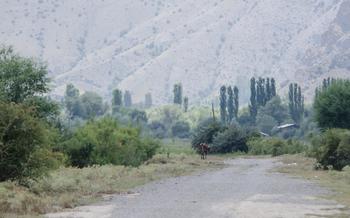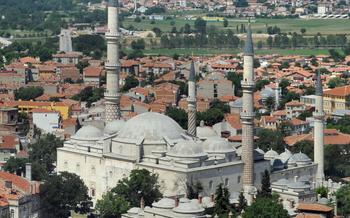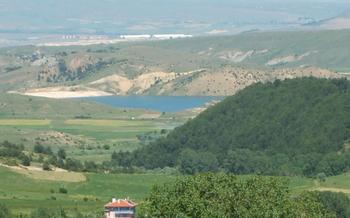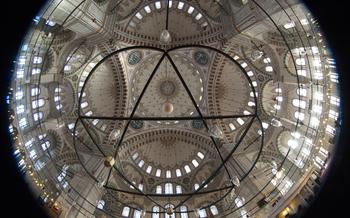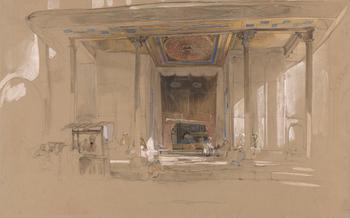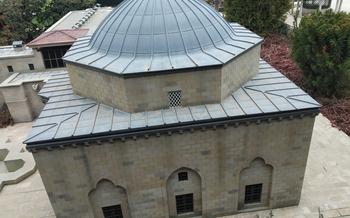
Orta Hisar Mosque
- Orta Hisar Mosque: An Architectural Masterpiece
- The Grand Courtyard: A Place of Tranquility
- The Prayer Hall: A Showcase of Islamic Art
- The Minaret: A Symbol of Divine Presence
- The History of Orta Hisar Mosque: A Journey Through Time
- The Cultural Significance of Orta Hisar Mosque
- Visiting the Orta Hisar Mosque: Practical Information
- Discover the Surrounding Area: Unveiling Çankırı's Charms
- The Legacy of the Architect: Sinan's Masterpiece
- The Beauty of Iznik Tiles: A Visual Feast
- The Prayer Niche: A Focus of Devotion
- The Role of Orta Hisar Mosque in the Community
- A Glimpse into Turkish Islamic Architecture: Orta Hisar as an Example
- Photography and Art Appreciation at Orta Hisar Mosque
- Insider Tip: Unveiling the Hidden Gem
Orta Hisar Mosque: An Architectural Masterpiece
The Orta Hisar Mosque stands as a testament to the architectural prowess of the Ottoman Empire. Constructed during the reign of Sultan Murad III in the late 16th century, this magnificent structure is a masterpiece of Islamic architecture, renowned for its grandeur, intricate details, and historical significance.
Historical Significance:
Orta Hisar Mosque holds a prominent place in the annals of Turkish history. It was built as part of a larger complex that included a caravanserai, a bathhouse, and a hospital, serving as a vital hub for travelers, merchants, and pilgrims along the historic Silk Road. The mosque has witnessed centuries of religious, social, and cultural transformations, serving as a place of worship, learning, and community gatherings.
Architectural Features:
The mosque's architectural style blends traditional Ottoman elements with influences from Byzantine and Seljuk architecture. Its most striking feature is the grand dome, which rests upon an octagonal drum and is adorned with intricate geometric patterns and calligraphy. The interior of the mosque is equally impressive, featuring a spacious prayer hall supported by elegant columns and arches, creating a sense of awe and serenity.
Location and Accessibility:
Orta Hisar Mosque is strategically situated in the heart of Çankırı, a city in central Turkey. It is easily accessible by various modes of transportation, including buses, trains, and private vehicles. Visitors can find ample parking spaces in the vicinity of the mosque, making it convenient for those traveling by car.
The Grand Courtyard: A Place of Tranquility
The grand courtyard of the Orta Hisar Mosque invites visitors to immerse themselves in a serene and tranquil atmosphere. Surrounded by elegant arches and intricate tilework, this expansive space exudes an aura of peacefulness. The courtyard serves as an open area for ablution and contemplation, where visitors can purify themselves before entering the sacred space of the mosque.
Strolling through the courtyard, one can admire the meticulous attention to detail in its design. The intricate geometric patterns of the tilework, the cascading arches, and the soothing water features create a harmonious visual symphony. Islamic art and symbolism are interwoven throughout the courtyard, reflecting the rich cultural heritage that this mosque represents.
As the sun casts its warm glow upon the courtyard, creating a play of light and shadow, a sense of serenity envelops the surroundings. The gentle sound of water flowing from the fountains adds to the ambiance, creating a soothing melody that calms the mind and spirit. The grand courtyard of the Orta Hisar Mosque stands as an oasis of tranquility, inviting visitors to pause, reflect, and connect with their inner selves.
The Prayer Hall: A Showcase of Islamic Art
The prayer hall of the Orta Hisar Mosque is a breathtaking spectacle, a testament to the artistry and devotion of its creators. Its vast interior is defined by rows of elegant columns supporting a series of domes, each adorned with intricate designs and patterns. The walls are covered in vibrant Iznik tiles, their colors and motifs telling stories from the Quran and Islamic history. Verses from the holy book are inscribed in elegant calligraphy, adding to the sacred ambiance of the space. The mihrab, or prayer niche, is a masterpiece in itself, featuring intricate carvings and colorful tiles that draw the eye towards Mecca, the direction of prayer. The pulpit, or minbar, is an equally impressive work of art, its intricate carvings and inlaid mother-of-pearl adding to the overall grandeur of the hall. The prayer hall is not just a place of worship, but also a testament to the artistry and craftsmanship of the Ottoman era. Its beauty and grandeur inspire awe and reverence in visitors, leaving them with a sense of wonder and tranquility.
The Minaret: A Symbol of Divine Presence
A Towering Symbol of Faith: The minaret of Orta Hisar Mosque stands tall and majestic, a prominent landmark that can be seen from afar. Its slender cylindrical form rises towards the heavens, symbolizing the connection between the earthly realm and the divine. The minaret's height and grandeur serve as a reminder of the greatness of Allah and the importance of faith in the lives of Muslims.
Functionality and Significance: The primary function of the minaret is to serve as a platform for the muezzin, or caller to prayer. Five times a day, the muezzin ascends the minaret and recites the adhan, or call to prayer, inviting the faithful to gather for their prayers. The melodious voice of the muezzin reverberates through the air, echoing across the city and calling upon the believers to fulfill their religious obligations.
Panoramic Views: For those who have the privilege of climbing the minaret, a breathtaking panorama awaits. The winding streets of Çankırı, the lush green hills, and the distant mountains unfold before the eyes, creating a picturesque landscape. The climb to the top is well worth the effort, as the views from the minaret offer a unique perspective of the city and its surroundings.
The History of Orta Hisar Mosque: A Journey Through Time
The Orta Hisar Mosque's history is deeply intertwined with the cultural and religious fabric of Çankırı. It was built during the Ottoman period, around the 16th century, during the reign of Sultan Süleyman the Magnificent. The architect responsible for its creation was the renowned Mimar Sinan, one of the most influential figures in Islamic architecture.
The mosque underwent several renovations and expansions over the centuries. In the 18th century, it was enlarged and its courtyard was redesigned. During the 19th century, the mosque was damaged by a fire, but it was subsequently restored and renovated. In the early 20th century, the mosque underwent another round of renovations, which included the addition of new features and the restoration of its original decorations.
Throughout its history, the Orta Hisar Mosque has played a significant role in the religious and cultural life of Çankırı. It has been a place of worship, a center for Islamic learning, and a venue for social gatherings and community events. Today, the mosque continues to serve as an important religious and cultural landmark, attracting visitors from all over the region.
The mosque's enduring legacy is a testament to its architectural significance and its deep roots in the history and culture of Çankırı. Its well-preserved state and its ongoing use as a place of worship make it a valuable example of Ottoman-era architecture and an important part of the city's heritage.
The Cultural Significance of Orta Hisar Mosque
A Symbol of Cultural Heritage and Turkish Identity
Orta Hisar Mosque stands as a testament to the rich cultural heritage of Turkey. Its architectural style and design embody the principles of Islamic architecture, demonstrating the deep-rooted traditions and beliefs of the Turkish people. The mosque serves as a symbol of cultural continuity, connecting the present with the past and preserving the legacy of Islamic art and architecture in Turkey.
The mosque's intricate details, Iznik tiles, and calligraphy showcase the artistic prowess of Turkish craftsmen. It represents the fusion of Islamic and Turkish influences, creating a unique and harmonious blend of architectural elements. The mosque has become an iconic landmark, symbolizing the cultural identity of Turkey and its enduring contribution to Islamic architecture.
The Orta Hisar Mosque is a living example of Turkey's vibrant cultural heritage. It attracts visitors from around the world who come to admire its beauty, learn about its history, and experience the spiritual atmosphere that permeates its walls. The mosque stands as a reminder of the rich cultural tapestry that makes Turkey a unique and fascinating destination.
Visiting the Orta Hisar Mosque: Practical Information
Visiting hours and guidelines:
The Orta Hisar Mosque is open to visitors from dawn to dusk, seven days a week. Entry is free of charge, but donations are welcome. Visitors are requested to dress modestly and respectfully, covering their shoulders and knees. Women may also choose to cover their hair. Photography is permitted inside the mosque, but visitors are asked to be mindful of the worshippers and avoid using flash.
Dress code and etiquette:
When visiting the Orta Hisar Mosque, it is important to dress and behave respectfully. Visitors should avoid wearing revealing or tight-fitting clothing, and should cover their shoulders and knees. Women may also choose to cover their hair. It is also important to be mindful of the worshippers and avoid talking loudly or disturbing them in any way.
Guided tours and availability:
Guided tours of the Orta Hisar Mosque are available upon request. Tours can be arranged in English, Turkish, and several other languages. Visitors should contact the mosque in advance to book a tour.
Discover the Surrounding Area: Unveiling Çankırı's Charms
Beyond the walls of the Orta Hisar Mosque, Çankırı unveils a treasure trove of historical and natural wonders. Embark on a journey to explore the nearby historical sites that tell tales of the region's rich past. Discover ancient ruins, majestic castles, and architectural marvels that transport you back in time.
Immerse yourself in the breathtaking natural beauty of Çankırı. Explore lush forests, tranquil lakes, and towering mountains that offer a sanctuary of serenity and tranquility. Whether you prefer hiking amidst picturesque landscapes or simply basking in the warmth of nature, Çankırı's natural wonders will leave you captivated.
Indulge in the local cuisine, a symphony of flavors that reflects the region's cultural heritage. Tantalize your taste buds with traditional Turkish dishes, savoring the freshness of local ingredients and the expertise of skilled chefs. From savory kebabs to delectable sweets, Çankırı's culinary delights are a feast for the senses.
The Legacy of the Architect: Sinan's Masterpiece
The Orta Hisar Mosque stands as a testament to the brilliance of the renowned architect, Mimar Sinan. Sinan, a legendary figure in Islamic architecture, left an indelible mark on the landscape of the Ottoman Empire with his groundbreaking designs and innovative techniques. His contributions to Islamic architecture are widely recognized, and the Orta Hisar Mosque is no exception.
Sinan's expertise in integrating traditional Islamic motifs with contemporary architectural styles is evident in the mosque's design. The harmonious blend of classical Ottoman and Seljuk architectural elements creates a visually captivating edifice that showcases Sinan's mastery. The mosque's layout, with its central dome and four semi-domes, is a testament to his innovative approach to spatial organization.
The Orta Hisar Mosque is often compared to Sinan's other masterpieces, such as the Süleymaniye Mosque in Istanbul and the Selimiye Mosque in Edirne. While each of these mosques possesses its own unique characteristics, they all share a common thread: Sinan's exceptional ability to fuse aesthetics with functionality. His emphasis on structural integrity, combined with his artistic vision, resulted in buildings that have withstood the test of time and continue to inspire awe in visitors from around the world.
Sinan's influence on Turkish architecture is undeniable. His legacy extends far beyond the Orta Hisar Mosque, as his designs and techniques became the foundation for subsequent generations of architects. His contributions to Islamic architecture have left a lasting impact on the cultural and historical landscape of Turkey, making him one of the most revered figures in the field.
The Beauty of Iznik Tiles: A Visual Feast
The Orta Hisar Mosque is adorned with exquisite Iznik tiles, which are considered some of the finest examples of this art form. These tiles, produced in the city of Iznik during the Ottoman Empire, are renowned for their vibrant colors, intricate patterns, and historical significance.
The tiles in the Orta Hisar Mosque showcase a variety of designs, including floral motifs, geometric patterns, and calligraphic inscriptions. The vibrant blues, greens, and reds of the tiles create a stunning visual effect, adding a touch of splendor to the mosque's interior.
The production of Iznik tiles involved a complex process that required skilled artisans and specialized techniques. The tiles were made from a mixture of clay, quartz, and other minerals, which were then glazed and fired at high temperatures. The intricate designs were achieved through the use of stencils and hand-painting.
Beyond their aesthetic beauty, Iznik tiles also hold historical significance. They were often used to decorate important buildings, including mosques, palaces, and tombs. The tiles in the Orta Hisar Mosque are particularly notable as they date back to the 16th century, making them a valuable testament to Ottoman craftsmanship and artistry.
Exploring the Iznik tiles in the Orta Hisar Mosque is a journey through time, allowing visitors to appreciate the beauty and historical significance of this unique art form. Whether you're an art enthusiast or simply someone who appreciates beauty, the Iznik tiles in the Orta Hisar Mosque are sure to leave a lasting impression.
The Prayer Niche: A Focus of Devotion
The prayer niche, or mihrab, in the Orta Hisar Mosque is a remarkable architectural element that holds great significance in Islamic prayer and spirituality. Located in the center of the qibla wall, the mihrab indicates the direction of prayer towards Mecca, the holiest city in Islam. It serves as a focal point for the worshippers, guiding their attention and devotion during their prayers.
The mihrab in the Orta Hisar Mosque is intricately designed and beautifully decorated, showcasing the exquisite craftsmanship of the artisans who created it. Its arched shape is adorned with intricate carvings and calligraphy, featuring verses from the Quran that extol the glory of Allah and emphasize the importance of prayer. The mihrab's interior is adorned with colorful Iznik tiles, arranged in a harmonious pattern that enhances its visual appeal and spiritual significance.
The mihrab not only serves as a visual focal point but also plays an important role in the acoustics of the prayer hall. Its design and positioning ensure that the imam's voice during prayers is amplified and carries throughout the hall, enabling the worshippers to hear and follow the prayers more clearly.
Overall, the prayer niche in the Orta Hisar Mosque is a testament to the importance of prayer in Islam and the significance of sacred spaces in Islamic architecture. Its intricate design, beautiful decorations, and spiritual symbolism create a sense of reverence and devotion, making it a cherished element of the mosque.
The Role of Orta Hisar Mosque in the Community
Beyond its religious significance, the Orta Hisar Mosque has played a pivotal role in the social, cultural, and educational fabric of the Çankırı community. Serving as a gathering place for Muslims, the mosque fosters a sense of unity and belonging, facilitating interactions, discussions, and the exchange of ideas.
Throughout history, the mosque has hosted numerous social and cultural events, including religious festivals, celebrations, and gatherings. These events provide opportunities for community members to come together, strengthen their bonds, and celebrate their shared heritage. The mosque's spacious courtyard and prayer hall offer ample space for these gatherings, creating a vibrant and lively atmosphere.
Education has also been an integral aspect of the Orta Hisar Mosque's role in the community. In the past, the mosque served as a center for Islamic studies, with scholars and students gathering to learn about the religion, its teachings, and its history. This tradition of learning continues today, with the mosque hosting lectures, seminars, and workshops on various aspects of Islam and its culture.
In addition to its religious, social, and educational functions, the Orta Hisar Mosque also plays a significant role in charitable activities. The mosque's administration often organizes charitable events, such as food drives, clothing donations, and fundraising campaigns, to support those in need within the community. Through these initiatives, the mosque demonstrates its commitment to social responsibility and compassion.
A Glimpse into Turkish Islamic Architecture: Orta Hisar as an Example
Orta Hisar Mosque stands as a testament to the rich history and architectural prowess of Turkish Islamic architecture. Drawing inspiration from both Seljuk and Ottoman styles, the mosque showcases a harmonious blend of traditional elements and innovative design. The mosque's layout and orientation reflect the principles of Islamic architecture, ensuring that the qibla wall, or the direction of prayer, faces towards Mecca. The use of domes, arches, and vaults not only adds to the mosque's aesthetic appeal but also serves a functional purpose, providing structural stability and enhancing the acoustics for prayer recitations.
The incorporation of intricate tilework, calligraphy, and decorative motifs further enhances the mosque's visual appeal. Iznik tiles, renowned for their vibrant colors and intricate patterns, adorn the mihrab, or prayer niche, adding a touch of elegance and spirituality to the sacred space. The use of calligraphy, with verses from the Quran and hadiths inscribed on the walls and mihrab, serves as a reminder of the mosque's religious significance and provides a sense of reverence for worshippers.
Orta Hisar Mosque, with its architectural grandeur and symbolic elements, epitomizes the essence of Turkish Islamic architecture. It represents a fusion of cultural influences, artistic traditions, and religious beliefs, showcasing the unique identity and heritage of Turkey. Visiting this architectural masterpiece offers a glimpse into the rich history, artistic prowess, and spiritual significance of Islamic architecture in Turkey.
Photography and Art Appreciation at Orta Hisar Mosque
The Orta Hisar Mosque is not only a place of worship but also a stunning work of art that attracts photographers and art enthusiasts alike. With its intricate details, vibrant colors, and harmonious architecture, the mosque offers endless opportunities for artistic expression and appreciation.
When photographing the mosque, it's essential to capture its grandeur and beauty from different angles. The courtyard, with its serene atmosphere and symmetrical arches, makes for a stunning composition. The prayer hall's intricate designs and calligraphy provide a feast for the eyes, while the minaret's graceful silhouette against the sky is a sight to behold.
For a unique perspective, consider visiting the mosque during different times of the day. The warm glow of dawn or dusk casts a magical light on the mosque, creating an ethereal atmosphere. Night photography also offers a captivating experience, as the mosque's illuminated facade stands out against the dark sky.
Beyond photography, the mosque inspires artistic interpretations in various forms. Local artists often depict the mosque in their paintings, sculptures, and other artworks, capturing its essence and significance. These artistic renditions provide a fresh perspective on the mosque, allowing viewers to appreciate its beauty from a different lens.
As you explore the mosque, take time to appreciate the details that make it so special. Notice the delicate carvings, intricate tilework, and the subtle play of light and shadow. Whether you're a professional photographer or simply an art lover, the Orta Hisar Mosque is a treasure trove of visual delights waiting to be discovered and shared.
Insider Tip: Unveiling the Hidden Gem
As you delve deeper into the intricacies of Orta Hisar Mosque, you'll uncover hidden gems that reveal its true essence. Venture beyond the main courtyard and prayer hall to discover secluded corners adorned with intricate details often overlooked by casual visitors. These hidden spots offer unique perspectives and a chance to appreciate the mosque's architectural marvels up close.
One such gem is the rooftop terrace, accessible through a discreet staircase. From here, you'll be rewarded with breathtaking panoramic views of Çankırı, with the mosque's grand dome dominating the skyline. The surrounding cityscape stretches out before you, a tapestry of history and modernity.
Another hidden treasure lies within the mosque's library, a repository of ancient texts and manuscripts. Here, you can immerse yourself in the rich intellectual and spiritual heritage of the region. The library's serene atmosphere invites contemplation and reflection, allowing you to connect with the mosque's scholarly past.
To fully appreciate the hidden depths of Orta Hisar Mosque, engage with the locals. Strike up conversations with the friendly caretakers, who can share fascinating stories and insights about the mosque's history, traditions, and significance. Their personal anecdotes will bring the mosque to life, giving you a deeper understanding of its role in the community.
Remember, the true beauty of Orta Hisar Mosque lies not only in its grand architecture but also in its hidden corners and the stories they hold. By exploring these lesser-known aspects, you'll gain a deeper appreciation for this architectural masterpiece and the rich cultural heritage it represents.

